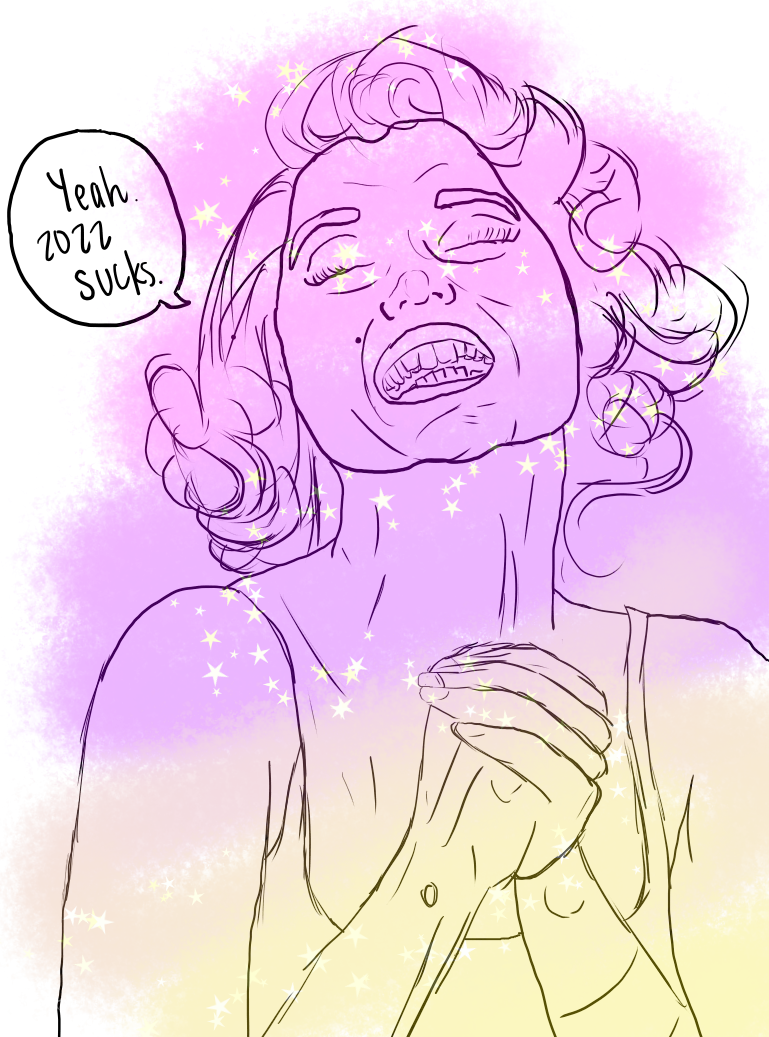Marilyn Monroe. Actress. Sex icon. A national symbol of light and beauty. There’s a certain nostalgia that surrounds the famous blonde bombshell of the 50s. When we think of her, we think of the glamor, the diamonds, the fame, the red carpets, the vintage black-and-white reels.
Andrew Dominik’s fictional biopic of Monroe, Blonde, which recently dropped on Netflix towards the end of September, erases all that nostalgia and simultaneously adds onto it.
The first thing I think of when I recall the film is DADDY ISSUES. The movie starts off with a shot of young Marilyn, also known as Norma Jeane, and her mother as they examine a photo of Marilyn’s mysterious father together. The tone of the scene quickly changes when all of a sudden, the screen is orange and Marilyn’s mother is driving straight towards a forest fire, trying to escape her troubled life. When a police officer makes her turn around and go back home, Marilyn’s mother strips naked because of the heat and then tries to drown Marilyn in a fit of rage and grief- one of the first of many sexualizations of female distress that take place throughout the film. Besides the scarce amount of letters that he sends, Marilyn has limited contact with her father throughout the story. It proves to be a defining factor in her life, according to the movie. She marries older men, calling them ‘Daddy’ as a token of affection.
The film takes us through Marilyn’s troubled life: her parental issues, problems with identity and wanting to show the world Norma Jeane instead of Marilyn Monroe, multiple relationships and marriages, her entrance into the acting world, eventual drug and alcohol abuse, and more.
It’s important to remember that this movie is grossly fictional, and for many critics of the movie, a gross exploitation of both Marilyn Monroe and Ana de Armas who played her. I have to say that I agree. Ana de Armas played the part of Marilyn beautifully. Her dreamy, airy voice was spot on and the makeup artists and stylists that worked on this film deserve to be known for their work, but so much else could have- and should have- been fixed.
The second thing that I think of when I recall my experience watching Blonde is that trigger warnings were necessary. There are multiple instances where we see Marilyn being abused by the men in her life. While not shown fully on screen, we can hear Marilyn being raped by a producer from whom she is trying to get a job, her first husband Joe DiMaggio, and even President Nixon. The worst part, however, was the scene where Marilyn is forced to have an abortion. It was absolutely horrifying and uncomfortable and unnecessary.
What I disliked most about this film was how it was almost determined to portray Marilyn as a victim. Doe-eyed and innocent, Ana de Armas spends the whole film sucking up to the men around her. And because the film was not set up in a linear way, we jump from relationship to relationship with no resolution to the abuse and no depiction of how Marilyn takes it besides aesthetically pleasing black-and-white shots of Armas crying with her red lipstick nicely done and mascara gracefully running down her cheeks. There was a lot in Blonde that was inaccurate about Marilyn’s life, but I wish so bad that they would have at least included something about when Marilyn actually did stand up for herself in real life.
Her famous movie, ‘Gentlemen Prefer Blondes’ turned out to be Fox’s highest-earning film, but she still wasn’t getting roles with any substance. When they sent her her next script that featured another mediocre character, Marilyn sent it back with the word ‘TRASH’ written on the cover and refused to show up to shoot. That’s the confident Marilyn that should have been portrayed in this movie, rather than the singular scene we got of Ana de Armas screaming at her colleagues in a random, hysterical manner.
I went into this movie aware of what critics had to say about it: that it was sexist, demeaning and generally not good. Overall, I must agree. I would say the only good part of the film was the aesthetic and cinematography, but even the constant switching between black-and-white and colored shots got confusing.
If you’re looking to learn more about Marilyn Monroe and her life and career, I would recommend watching The Mystery of Marilyn Monroe: The Unheard Tapes, which is also available on Netflix.
Alefiya Presswala is a Freshman Journalism major who can give a presentation about Marilyn Monroe’s life anytime, anywhere. They can be reached at apresswala@ithaca.edu.
Art by Julia Young.

